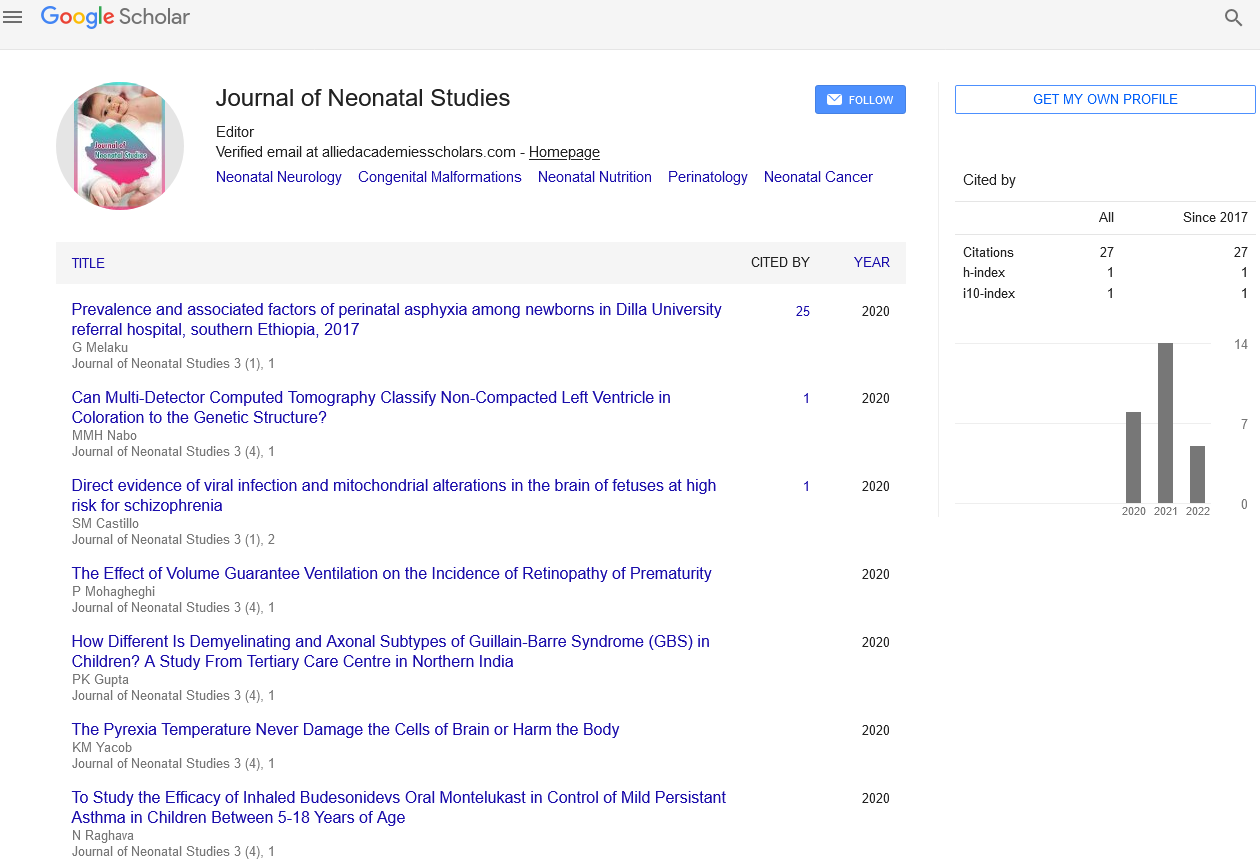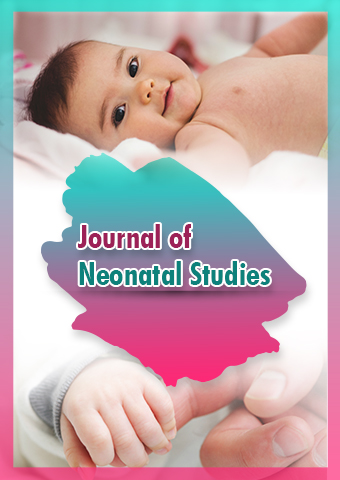Review Article - Journal of Neonatal Studies (2023) Volume 6, Issue 4
Neonatal Diseases & Disorders: Understanding the Challenges of Early Life
Anshika Singh*
Department of Stem Cell and Research, India
Department of Stem Cell and Research, India
E-mail: anshikauvari@gmail.com
Received: 01-Aug-2023, Manuscript No. jns-23-109483; Editor assigned: 2-Aug-2023, PreQC No. jns-23- 109483(PQ); Reviewed: 15-Aug-2023, QC No. jns-23-109483; Revised: 22-Aug-2023, Manuscript No. jns-23- 109483(R); Published: 29-Aug-2023; DOI: 10.37532/jns.2023.6(4).96-99
Abstract
Neonatal diseases and disorders are a significant public health concern, affecting newborns during the first 28 days of life. This critical period represents a vulnerable phase of development, where prompt diagnosis and appropriate management are essential for optimal outcomes. Neonatal diseases encompass a broad spectrum of conditions, ranging from common physiological adaptations to lifethreatening medical emergencies. This abstract provides an overview of the major neonatal diseases and disorders, highlighting their epidemiology, etiology, clinical presentation, and management approaches. Key topics covered include respiratory distress syndrome, neonatal infections, congenital anomalies, neurologic disorders, and metabolic abnormalities. Advances in medical technology and neonatal care have improved survival rates and quality of life for affected infants, but challenges remain in ensuring equitable access to specialized care and preventive measures. Addressing neonatal diseases and disorders requires a multi-disciplinary approach involving healthcare professionals, policymakers, and communities, focusing on early detection, timely interventions, and continuous research to enhance neonatal health outcomes. Neonatal diseases and disorders encompass a wide range of medical conditions that affect infants during the first 28 days of life. These critical early days present unique challenges for neonates, as their organs and systems are still developing and adapting to the extra uterine environment. Neonatal care has made significant progress over the years, but these vulnerable infants remain susceptible to a host of complications that can lead to morbidity and mortality. This abstract provides an overview of the major neonatal diseases and disorders, discussing their etiology, clinical manifestations, diagnosis, and treatment options. Understanding these conditions is crucial for healthcare professionals to optimize care and improve outcomes for newborns during this critical period.
Keywords
Neonatal diseases • Neonatal disorders • Newborn • Neonate • Respiratory distress syndrome • Neonatal infections • Congenital anomalies • Neurologic disorders • Metabolic abnormalities • Neonatal care • Early detection • Timely interventions • Medical emergencies • Public health • Medical technology • Pediatric health
Introduction
The neonatal period, defined as the first 28 days of life, is a critical phase in a human’s development. During this time, newborns undergo significant physiological adaptations as they transition from the intrauterine to the extra uterine environment. Despite the marvels of modern medicine and advancements in maternal and neonatal care, neonatal diseases and disorders remain a significant global health challenge. In this article, we will explore some of the most common neonatal diseases and disorders, their causes, symptoms, diagnostic approaches, and available treatment options. Understanding these conditions is vital for healthcare professionals, parents, and caregivers to promote early detection, proper management, and improved outcomes for neonates [1].
The neonatal period, defined as the first 28 days of life, represents a crucial phase in human development. During this time, infants undergo rapid growth and adaptation to life outside the maternal womb, making them particularly susceptible to various diseases and disorders. Neonatal healthcare has witnessed remarkable advancements over the years, leading to significant reductions in neonatal mortality rates. However, neonatal diseases and disorders continue to challenge healthcare professionals, demanding continued research and innovation to improve outcomes for these vulnerable patients [2].
Neonatal diseases and disorders can arise due to a combination of genetic, environmental, and prenatal factors. Prematurity, low birth weight, birth asphyxia, and maternal infections are among the leading contributors to neonatal morbidity and mortality. The unique physiology of newborns, coupled with their limited capacity to mount effective immune responses, further exacerbates the complexity of managing these conditions. In this paper, we aim to provide a comprehensive overview of the major neonatal diseases and disorders encountered in clinical practice. We will explore the etiology, clinical manifestations, diagnostic approaches, and current treatment modalities for each condition. Furthermore, we will discuss the challenges faced by healthcare providers in delivering optimal care to neonates and delve into the latest research and strategies aimed at reducing the burden of neonatal diseases. Improving neonatal outcomes requires a multidisciplinary approach, involving neonatologists, pediatricians, nurses, and other healthcare professionals. Additionally, advances in medical technology, early screening, and preventative measures play a pivotal role in identifying and managing neonatal diseases effectively. Through a better understanding of these diseases and disorders, we can enhance neonatal care, fostering healthier beginnings for newborns and empowering them to thrive as they embark on their journey of life [3].
Discussion
Prematurity
Premature birth, defined as birth before 37 weeks of gestation, is a leading cause of neonatal morbidity and mortality worldwide. Preterm infants face multiple challenges as their organ systems are often not fully developed. Common complications of prematurity include Respiratory Distress Syndrome (RDS), Intra Ventricular Hemorrhage (IVH), Necrotizing Entero Colitis (NEC), and developmental delays. To reduce the burden of prematurity, prenatal care and awareness of risk factors are crucial [4].
Respiratory distress syndrome (RDS)
RDS is one of the most common respiratory problems in preterm infants. It results from insufficient surfactant production, which leads to alveolar collapse and difficulty in breathing. RDS typically manifests within hours after birth and requires prompt respiratory support and exogenous surfactant administration. Advancements in neonatal intensive care have significantly improved RDS outcomes, but it remains a significant concern, particularly in very preterm infants [5].
Jaundice
Neonatal jaundice is a prevalent condition characterized by the yellowish discoloration of the skin and eyes due to elevated bilirubin levels. In most cases, jaundice is a benign and self-limiting condition, but in some cases, it may indicate severe underlying pathologies such as hemolytic disease, sepsis, or metabolic disorders. Phototherapy and, in severe cases, exchange transfusions are the mainstay of treatment [6].
Congenital heart defects
Congenital heart defects (CHDs) are structural abnormalities of the heart that are present at birth. CHDs vary widely in severity, from mild conditions requiring no intervention to complex malformations necessitating immediate surgical intervention. Early detection through prenatal screening and postnatal examinations is vital for timely management and improved outcomes [7].
Sepsis
Neonatal sepsis is a life-threatening condition resulting from a bacterial, viral, or fungal infection in the first month of life. The clinical presentation can be subtle, making early diagnosis challenging. Prompt initiation of antibiotic therapy is essential to improve survival rates. Preventive measures, such as proper hand hygiene and aseptic techniques, can significantly reduce the risk of sepsis in neonates [8].
Neural tube defects (NTDs)
Neural tube defects occur during embryonic development when the neural tube, which eventually forms the brain and spinal cord, fails to close properly. Spina bifida and anencephaly are common NTDs that can lead to lifelong disabilities or even be fatal. Folic acid supplementation during pregnancy is a proven preventive measure against NTDs [9].
Neonatal abstinence syndrome (NAS)
NAS occurs when a newborn experiences withdrawal symptoms due to exposure to drugs, typically opioids, during pregnancy. The rise in opioid abuse has led to an increase in NAS cases. Infants with NAS require specialized care and treatment to manage withdrawal symptoms and promote healthy development [10].
Conclusion
Neonatal diseases and disorders pose significant challenges to the health and well-being of newborns and their families. Early detection, proper management, and preventive measures are essential in reducing neonatal morbidity and mortality. Advancements in medical technology and neonatal care have undoubtedly improved outcomes, but there is still much work to be done. Efforts must continue to focus on improving prenatal care, raising awareness about risk factors, and providing comprehensive neonatal care. Additionally, ongoing research and public health initiatives are crucial to further understand neonatal diseases and disorders and to develop innovative strategies to tackle them effectively. As a society, we must come together to support neonatal healthcare systems, promote education for healthcare professionals and parents, and advocate for policies that prioritize the health and well-being of our tiniest and most vulnerable members. By doing so, we can strive for a future where every newborn has the best possible start in life, free from the burden of preventable neonatal diseases and disorders. Neonatal diseases and disorders represent a significant challenge in the field of pediatrics and maternal healthcare. The vulnerability of newborns to a wide range of conditions requires meticulous attention, timely interventions, and comprehensive medical care. The prevalence of neonatal diseases varies across regions and is influenced by socioeconomic factors, access to healthcare, and maternal health during pregnancy.
Neonatal diseases can encompass a spectrum of conditions, ranging from congenital anomalies and genetic disorders to infections and respiratory distress syndrome. Prematurity and low birth weight continue to be major contributors to neonatal morbidity and mortality, necessitating continuous advancements in medical technology and neonatal intensive care. Early detection and prompt intervention are vital in improving outcomes for neonates with diseases and disorders. Prenatal screenings, antenatal care, and education for expectant mothers play a crucial role in reducing the incidence and severity of neonatal conditions. Moreover, investment in research and medical advancements is pivotal in understanding the underlying causes of these diseases and developing innovative treatment strategies.
As medical knowledge and technology continue to progress, there is hope for further advancements in neonatal care, leading to reduced mortality rates and improved long-term outcomes for neonates affected by diseases and disorders. By working together and prioritizing neonatal health, we can strive to create a healthier and brighter future for the youngest members of our society.
Acknowledgement
None
Conflict of Interest
None
References
- Salinet ASM. Do acute stroke patients develop hypocapnia? A systematic review and meta-analysis. J Neurol Sci. 15, 1005-1010 (2019).
- Jellish WS. General Anesthesia versus conscious sedation for the endovascular treatment of acute ischemic stroke. J Stroke Cerebrovasc Dis. 25, 338-341 (2015).
- Rasmussen M.The influence of blood pressure management on neurological outcome in endovascular therapy for acute ischaemic stroke. Br J Anaesth. 25, 338-341 (2018).
- Südfeld S.Post-induction hypotension and early intraoperative hypotension associated with general anaesthesia. Br J Anaesth. 81, 525-530 (2017).
- Campbell BCV.Effect of general anesthesia on functional outcome in patients with anterior circulation ischemic stroke having endovascular thrombectomy versus standard care: a meta-analysis of individual patient’s data. Lancet Neurol. 41, 416-430 (2018).
- Wu L.General anesthesia vs local anesthesia during mechanical thrombectomy in acute ischemic stroke. J Neurol Sci. 41, 754-765 (2019).
- Goyal M.Endovascular thrombectomy after large vessel ischaemic stroke: a meta- analysis of individual patient data from five randomised trials. Lancet. 22, 416-430 (2016).
- Headey D. Developmental drivers of nutrional change: a cross-country analysis. World Dev. 42, 76-88 (2013).
- Deaton A, Dreze J. Food and nutrition in India: facts and interpretations. Econ Polit Wkly. 42– 65 (2008).
- Headey DD, Chiu A, Kadiyala S. Agriculture's role in the Indian enigma: help or hindrance to the crisis of undernutrition? Food security. 4, 87-102 (2012).
Indexed at, Google Scholar, Crossref
Indexed at, Google Scholar, Crossref
Indexed at, Google Scholar, Crossref
Indexed at, Google Scholar, Crossref
Indexed at, Google Scholar, Crossref
Indexed at, Google Scholar, Crossref
Indexed at, Google Scholar, Crossref

